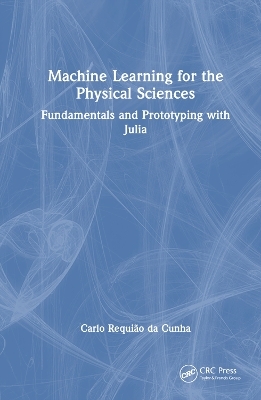
Machine Learning for the Physical Sciences
CRC Press (Verlag)
978-1-032-39229-5 (ISBN)
This textbook bridges this gap, providing an introduction to the mathematical foundations for the main algorithms used in machine learning for those from the physical sciences, without a formal background in computer science. It demon- strates how machine learning can be used to solve problems in physics and engineering, targeting senior undergraduate and graduate students in physics and electrical engineering, alongside advanced researchers.
All codes are available on the author's website: C•Lab (nau.edu)
They are also available on GitHub: https://github.com/StxGuy/MachineLearning
Key Features:
Includes detailed algorithms.
Supplemented by codes in Julia: a high-performing language and one that is easy to read for those in the natural sciences.
All algorithms are presented with a good mathematical background.
Carlo R. da Cunha is currently an assistant professor at the School of Informatics, Computing, and Cyber Systems at Northern Arizona University. He holds a Ph.D. degree in electrical engineering from Arizona State University. Throughout his career, Dr. da Cunha has held various academic positions and research affiliations in institutions such as McGill University, Chiba University, and the Technical University of Vienna. His research focuses on computational science, where he applies machine learning techniques to the design of innovative electronic devices and systems.
Chapter 1: Multivariate Calculus. Chapter 2: Probability Theory. Chapter 3: Dimensionality Reduction. Chapter 4: Cluster Analysis. Chapter 5: Vector Quantization Techniques. Chapter 6: Regression Models. Chapter 7: Classification. Chapter 8: Feedforward Networks. Chapter 9: Advanced Network Architectures. Chapter 10: Value Methods. Chapter 11: Gradient Methods. Chapter 12: Population-Based Metaheuristic Methods. Chapter 13: Local Search methods. Appendix A: Sufficient Statistic. Appendix B: Graphs. Appendix C: Sequential Minimization Optimization. Appendix D: Algorithmic Differentiation. Appendix E: Batch Normalizing Transform. Appendix F: Divergence of Two Gaussian Distributions. Appendix G: Continuous-time Bellman's Equation. Appendix H: Conjugate Gradient. Appendix I: Importance Sampling. References. Index.
| Erscheinungsdatum | 13.12.2023 |
|---|---|
| Zusatzinfo | 9 Tables, black and white; 87 Line drawings, black and white; 3 Halftones, black and white; 90 Illustrations, black and white |
| Verlagsort | London |
| Sprache | englisch |
| Maße | 156 x 234 mm |
| Gewicht | 689 g |
| Themenwelt | Informatik ► Theorie / Studium ► Algorithmen |
| Informatik ► Theorie / Studium ► Künstliche Intelligenz / Robotik | |
| Mathematik / Informatik ► Mathematik ► Angewandte Mathematik | |
| Naturwissenschaften ► Biologie | |
| Technik ► Elektrotechnik / Energietechnik | |
| Technik ► Umwelttechnik / Biotechnologie | |
| ISBN-10 | 1-032-39229-0 / 1032392290 |
| ISBN-13 | 978-1-032-39229-5 / 9781032392295 |
| Zustand | Neuware |
| Haben Sie eine Frage zum Produkt? |
aus dem Bereich


